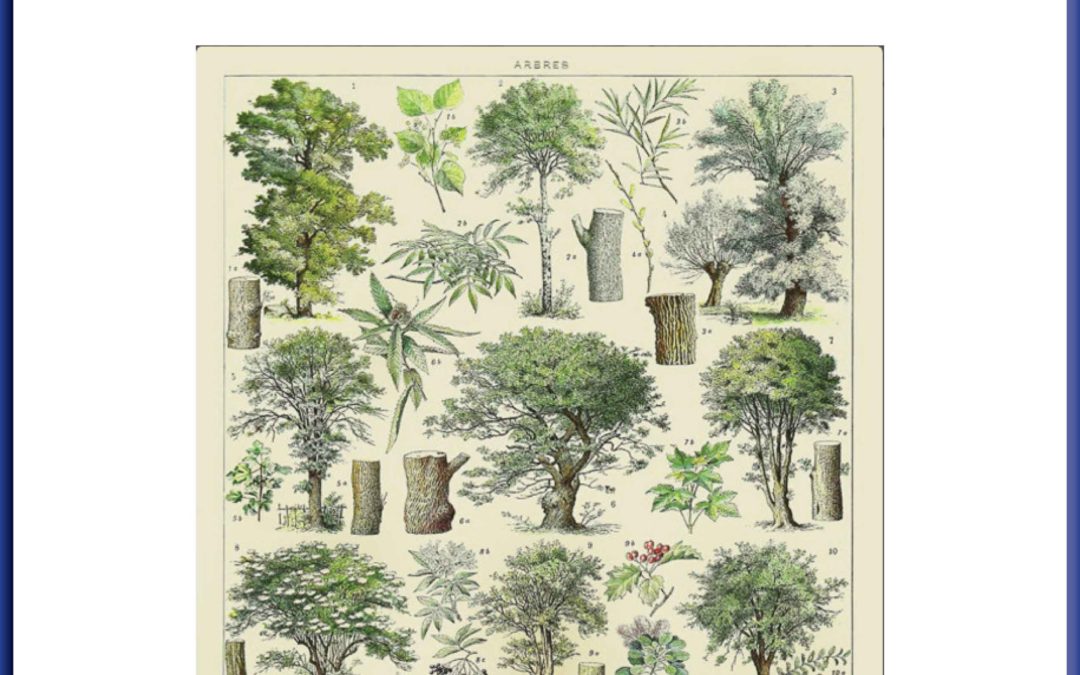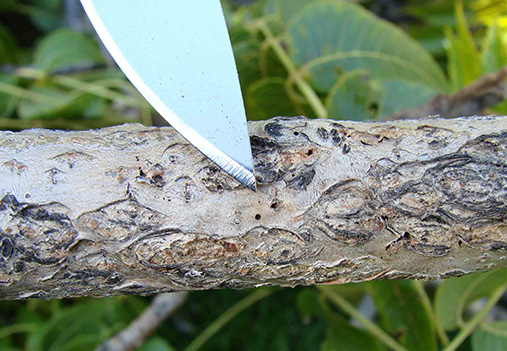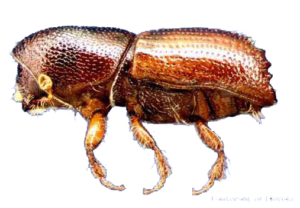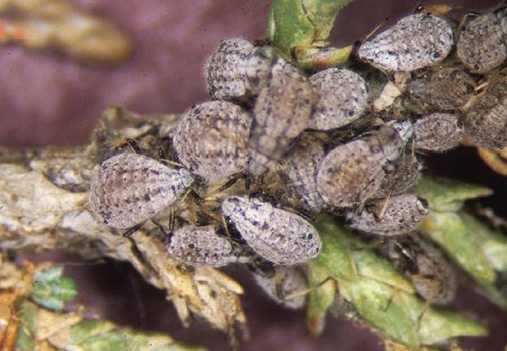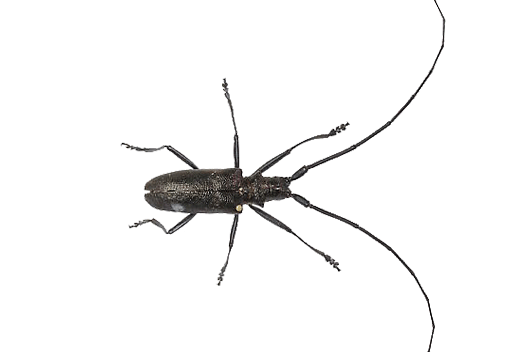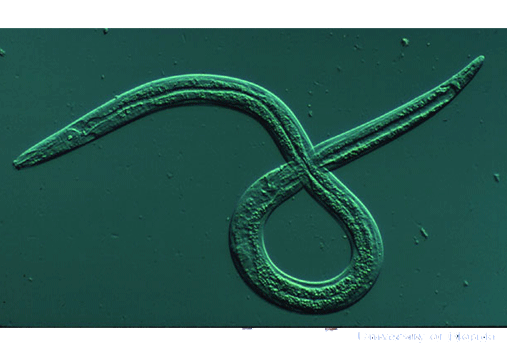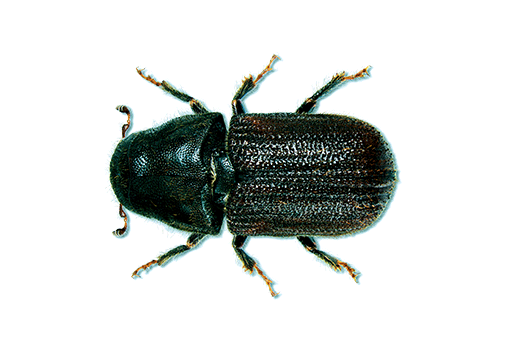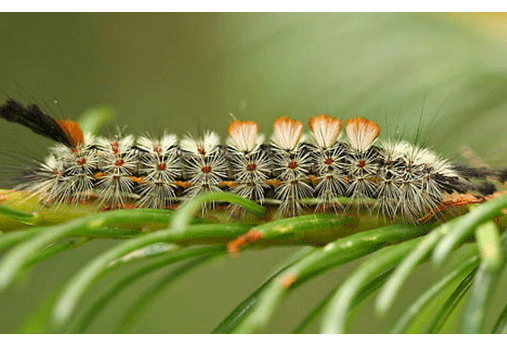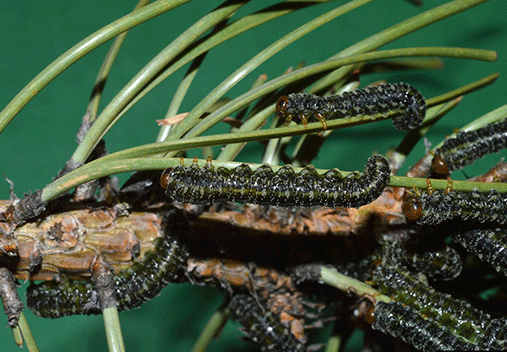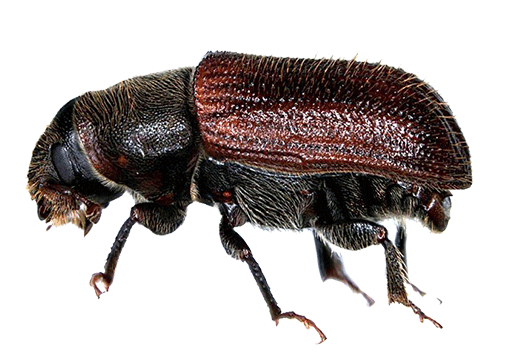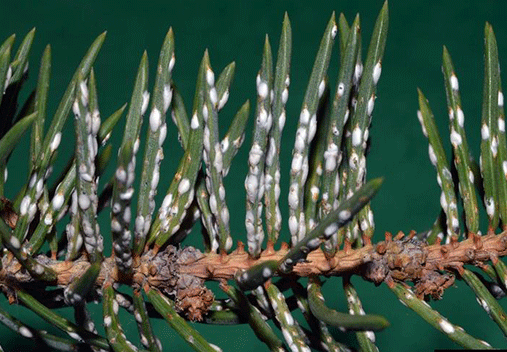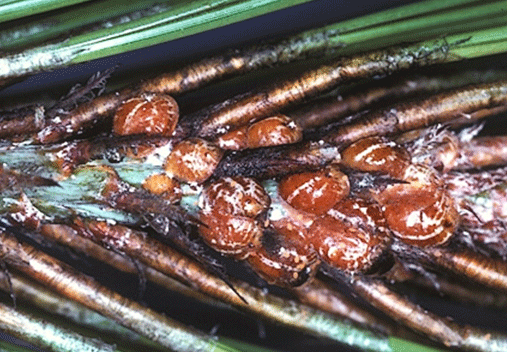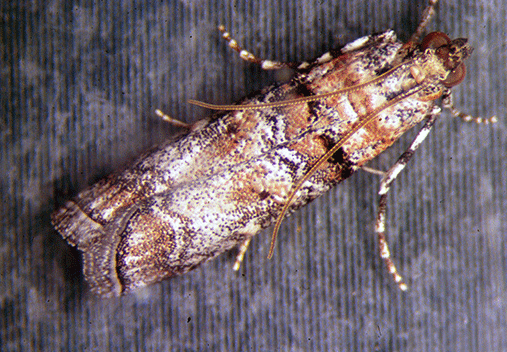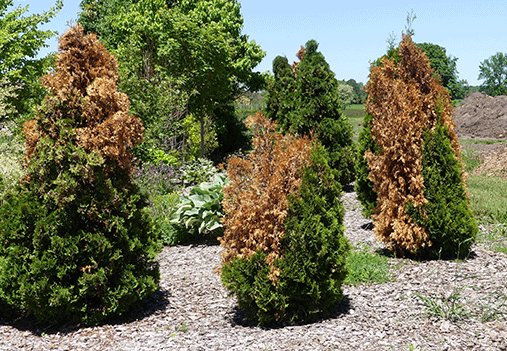How Do I Keep My Evergreen Trees Healthy In Denver?
Ross Tree publishes handbooks on key tree issues common to the Denver area. The Pine Tree Care Handbook identifies pines and other conifers that grow here and the insects and diseases that inflict them. Colorado has eleven conifers and three deciduous tree species that grow naturally in the state. The conifers include Bristlecone, Limber, Lodgepole, Ponderosa, and Piñon pines, Colorado Blue and Engelmann spruces, Douglas, and White firs. Norway spruce, Scotch pine, Arborvitae, and Austrian pines are popular trees in Denver but are not native to Colorado. Our crews are seeing a lot of borers and aphids in the late spring and summer this year, many on conifer trees. Check our blogs the following blogs for more information.
Surprising Rise in Tree Borers this Spring in Denver
Surprising Rise in Tree Aphids This Summer in Denver
What Is A Pine Tree?
It is helpful to know what species are growing in a yard and what insects attack them for proper pine tree care. Many people call all conifers pine trees, which is not unreasonable considering that the pine family (Pinaceae) is the most prominent family of conifers. Needle structure helps identify Conifers. On pine trees, needles are attached to the branches in clusters, while on spruce trees, needles are attached individually. Spruce tree needles are stiff to the touch, while fir tree needles are soft. All conifers produce cones that come from scales attached to a center stalk. Pinecone scales are woody and feel rigid. In contrast, spruce and fir cones have thinner scales and are flexible to the touch. Cone length is not helpful in tree identification.
Quick Facts From The Colorado State Extension…
- Most evergreens prefer full sun; some will tolerate partial shade. When selecting evergreens, consider available space, soil and site conditions, and weather factors.
- Evergreens have different soil moisture preferences. Group drought-tolerant types separately from those that require more moisture.
- All evergreens benefit from mulches. All need sufficient water to become established after transplanting.
- Most evergreens benefit from supplemental water during dry, warm, or windy periods from November to March.
Click here to go to the Colorado Extension webpage on Pine Tree Care.
How Tall Do Conifers Grow?
White fir, Douglas fir, Austrian pine, Ponderosa pine, Colorado Blue spruce, Engelmann spruce, and Norway spruce all grow tall. These trees grow over 100 feet tall, so the yard must have the clearance to manage this size.
Evergreens Commonly Found In Denver
For proper pine tree care, please use this information to identify your evergreen trees. Evergreen trees provide privacy, color, and shade throughout the year. Conifers look great in yards and so are planted extensively across Denver. Planting native trees make sense since they grow naturally in Colorado and perform exceptionally well when planted in soils and lighting conditions similar to their natural habitat. All the trees listed below make good yard trees. Each species has its unique moisture and sunlight needs to grow well in our arid climate.
Bristlecone Pine
Pinus aristata
The Bristlecone pine is one of Earth’s longest-living organisms. They make good accent trees since they do not grow tall.
Bark: Light gray and smooth when young; red-brown with irregular, scaly ridges when mature.
Leaves: Evergreen needles are dark with white lines; they have white pitch dots on both surfaces, to 1-inch long; crowded in a long, dense mass along the twig; generally 5 in a bundle.
Fruit: Cylindrical, dark purple-brown cones; 2 to 3 inches long; 4-sided cone scales with stiff curved points; brown seeds with black mottling and detachable wing.
Height: 15 to 30 feet
Habitat: They prefer full sun and acidic soils.
Pests: These trees have dense wood and tend to ward off insects.
Ponderosa Pine
Pinus ponderosa
Walking in the mountains through a mature Ponderosa forest is a sight to behold. So it is not surprising this tree in popular in Denver. The Ponderosa pine grows tall, tolerates Denver’s rocky and clay soils and has beautiful, red-brown bark at maturity. Ponderosa pine grow quickly and stand between 60 and 125 feet tall at maturity. The tree needs room to grow and its stands should be thinned for healthier growth.
Bark: Dark on young trees; nearly 3 inches thick, red-orange, and furrowed into large, flat scaly plates on mature trees.
Leaves: Evergreen needles are stiff, dark yellow-green; 3 to 7 inches long; typically in bundles of 3 that form tufts near the ends of branches.
Fruit: Light red-brown cones; 3 to 4 inches long; egg-shaped with scales that are tipped by a sharp point; small, long-winged seeds.
Height: 40 to 160 feet.
Habitat: Dry, nutrient-poor soils in open park-like stands.
Pests: Mountain Pine Beetle, Dwarf Mistletoe, Ips Beetle, Striped Pine Scale.
Pinyõn Pine
Pinus edulis
The Pinyon or Piñon pine grows slow and is long-lived with dense and compact branches and needles. The tree is a good choice for rock gardens and xeriscapes; they can grow into sphere-shapes, making a statement in any landscape.
Bark: Gray, smooth and thin when young; red-brown, rough, and furrowed into scaly ridges at maturity.
Leaves: Evergreen needles are stout and light green; 1 to 1-1/2 inches long; 2 in a bundle.
Fruit: Cones are yellow-brown, unique, short, and squatty; 1 to 2 inches long. Each cone contains 10 to 20 large, edible, oily seeds.
Height: 10 to 20 feet.
Habitat: Open woodlands; alone or with junipers on dry rocky foothills, mesas, and plateaus.
Pests and Diseases: Pitch Mass Borer, Ips Beetles, Pinyon Tip Moth, Pinyon Pitch Nodule Moth, Pinyon Needle Scale, and Pinyon Spindle Gall Midge. Common diseases are Black Stain Root Disease, Dwarf Mistletoe, and Armillaria Root Disease.
Limber Pine
Pinus flexilis
Like the Bristlecone, Limber pines are long-lived. There is a 1,660-year-old tree growing in South Park, Colorado. The pine species is fast growing, drought-resistant, and tolerates Denver’s clay soils. Their dense blue-green needles form an attractive pyramid shape. The tree stands 20 or 30 feet at maturity and works well in gardens or screening.
Bark: Light gray, thin and smooth on young trees; at maturity, dark brown, thick, and furrowed into scaly ridges. Young branches are very flexible, hence the name.
Leaves: Slender evergreen needles are blue-green with white lines on all surfaces; 2 to 3 inches long, typically 5 in a bundle.
Fruit: Yellow-brown, egg-shaped cones; thick, rounded cone scales that end in a blunt point; seeds are large with a very short wing.
Height: 20 to 30 feet.
Habitat: Nutrient-poor soils on dry, rocky slopes; ridges up to timberline and often pure stands.
Pests and Diseases: The tree is sought after for its ability to resist disease and pests.
Lodgepole Pine
Pinus contorta
Lodgepole pine forests cover slightly more than 1.5 million acres in Colorado or approximately 7 percent of the state’s forested lands. In the late 19th century, much of Colorado’s demand for railroad ties was supplied by lodgepole pine forests. Lodgepole pine forests grow and die uniformly.
Bark: Light brown, thin with many small scales.
Leaves: Evergreen needles are yellow to dark green; 1 to 3 inches long; sharply pointed, stiff, stout, slightly flattened and often twisted; 2 needles per bundle.
Fruit: Shiny, yellow-brown, egg-shaped, serotinous cones; to 2 inches long with raised, rounded cone scales and a tiny point. Serotinous cones release seeds when exposed to high heat from forest fires.
Height: 20 to 80 feet.
Habitat: Mostly well-drained soils in high elevations, often in pure stands.
Pests and Diseases: Mountain Pine Beetle.
Scotch Pine
Pinus sylvestris
Scotch pines are hardy and adaptable, featuring peeling showy orange bark when mature. They grow in most habits found in the Denver area. The trees work well as accents, windbreaks or shade trees.
Bark: The shaggy orange bark is extremely showy and adds to any landscape in the winter.
Leaves: Scotch pine has green foliage. The needles remain green throughout the winter.
Fruit: Neither the flowers nor the fruit are ornamentally significant.
Height: 30 to 50 feet.
Habitat: Scotch pine is native to northern Europe and Asia. They grow in most types of soil, but prefer moist, well-drained soils and do best in full sun.
Pests and Diseases: Zimmerman Pine Moths, Aphids, Pine Wilt, Mountain Pine Beetle.
Blue Spruce
Picea pungens
Blue and Engelmann spruces are ubiquitous in the older neighborhoods in Denver. These trees fill huge areas if given enough water to grow large.
Bark: Gray-brown with thick scales on mature trees.
Leaves: Evergreen needles are blue or light green with white lines; 1 to 1-1/4 inches long. Stiff and the points extremely sharp, light green with a white stripe.
Fruit: Shiny light brown, cylindrical cones; 2 to 4 inches long with thin, long, flexible and irregularly toothed scales; contains paired, long-winged seeds.
Height: 70 to 115 feet.
Habitat: Well-drained, sandy soils; moist sites of narrow bottomlands or along mountain streams; often in pure stands.
Pests and Diseases: Spruce Beetle, Ips Beetle, Cytospora Canker, Spider Mites, Spruce Needle Miner, and Yellowheaded Spruce Sawfly.
Engelmann Spruce
Picea engelmannii
Like the Blue spruce, these trees fill huge areas if given enough water to grow large.
Bark: Gray-brown, thick, with flaky scales.
Leaves: Evergreen needles are deep blue-green with white lines; 5/8 to 1 inch long; slender, sharp, and flexible; skunk-like odor when crushed.
Fruit: Light chestnut-colored, oblong cones; 1 to 2 inches long.
Height: 45 to 130 feet.
Habitat: High, cold forest environments on moist, northern slopes; with subalpine fir and other conifers.
Pests and Diseases: Spruce Beetle, Ips Beetle, Cytospora Canker, Spider Mites, Spruce Needle Miner, and Yellowheaded Spruce Sawfly.
Austrian Pine
Pinus nigra
The Austrian pine can be long-lived, with some trees over 500 years old. It needs full sun to grow well, is intolerant of shade, and is resistant to snow and ice damage. The tree grows fast, with a pyramidal shape that becomes a flat topped large tree at maturity.
Bark: The bark is gray to yellow-brown, and is widely split by flaking fissures into scaly plates, becoming increasingly fissured with age.
Leaves: The needles are thin and flexible. They attach to twigs in two-needle pairs and are stiff to the touch.
Fruit: They are known for the large white terminal buds at the end of branches. The cones grow between 2 to 4 inches long, with rounded scales that ripen from green to pale gray-buff or yellow-buff in the fall.
Height: 66 to 180 feet.
Habitat: Prefers moist soil with good drainage, but adaptable. They grow best in full sun. The tree is found in southern Europe, northwest Africa, and Asia Minor. The tree has naturalized in some areas of the U.S.
Pests and Diseases: Pine Wilt, Zimmerman Moth, Turpentine Beetles, scale insects.
Douglas Fir
Pseudotsuga menziesii
The Douglas fir grows fast, tall and wide. The tree withstands drought well and tolerates shade. The tree’s unique three-pronged bract cone makes it quite easy to spot.
Bark: Gray and smooth with resin blisters on young trees; red-brown, very thick and deeply furrowed with broad, often corky ridges at maturity.
Leaves: Evergreen needles are to 1-inch long with bracts at the base.
Fruit: Light brown, short-stalked cones that hang down from the branches; 1-1/3 to 3 inches long; many thin, rounded cone scales on top of long, three-pronged bracts that stick out beyond scales.
Height: 100 to 130 feet.
Habitat: Rocky soils of moist northern slopes; in pure stands and mixed conifer forests.
Pests and Diseases: Douglas-fir Beetle, Douglas Fir Tussock Moth, Fir Engraver.
White Fir
Abies concolor
White firs are beautiful and adaptable, but not for every location. Avoid planting in hot or dry sites. Their bluish-white color and neat spire-like shape and texture and color in landscapes.
Bark: Light gray and smooth with resin blisters on young trees; deeply furrowed into corky ridges and orange cracks when mature.
Leaves: Evergreen needles are light blue-green or silvery with white lines on both surfaces; 1 to 3 inches long; flat and rounded.
Fruit: Oblong, olive-green to blue cones; 3 to 5 inches long; upright on topmost twigs; fine, hairy cone scales; paired, long-winged seeds.
Height: 60 to 125 feet.
Habitat: Moist soils of high mountain valleys; in pure stands and with other firs.
Pests and Diseases: Douglas-fir Beetle, Douglas Fir Tussock Moth, Fir Engraver, Pine Sawyers, Giant Conifer Aphids, White Fir Needle Miner.
Arborvitae
Thuja occidentalis
Arborvitae trees are popular in Denver because of their compact, pyramidal forms and short height. The trees have dark green foliage that holds well in winter and like to be watered regularly. There are many varieties available for planting.
Bark: Brownish bark.
Leaves: Most arborvitaes have flattened, lacy aromatic needles, ranging from emerald green to gold.
Fruit: Clusters of rosebud-shaped cones measuring about ½ inch long appear in early summer, turning from green to nutmeg-brown.
Height: 10 to 20 feet.
Habitat: Arborvitae is native to North America and was the first tree from North America to be introduced to Europe when French explorers brought the tree to Paris. Many varieties are available depending on desired shape and height. Some trees can be maintained as a hedge.
Pests and Diseases: Arborvitaes are so popular because they have few insect and disease problems. However, if too crowded they can succumb to needle and twig blight caused by fungi.
How Do I Care For Evergreens?
Healthy conifer trees can ward off most of the insects and diseases listed above. However, homeowners need to remember that most of the deciduous and conifers seen around the Denver area are planted. Denver’s climate is great for growing grass, not so much for growing trees, so all trees here benefit from supplemental feedings and waterings throughout the year. We recommend four feedings per year. Click here for more information about deep root injections.
Healthy evergreens can flush out borers with sap and utilize other protective mechanisms to combat invasive pests. Each species needs a required amount of moisture and sunlight to maintain rigor. A certified arborist can help homeowners work out a fertilization and watering regimen to keep all their pines, spruces and firs healthy. Below are some tips to keep trees healthy.
Watering – All evergreens prefer well-drained soils. Planting pines, spruces and firs in wet, poorly drained, soggy areas is not a good idea. Pines should not be planted in irrigated lawns since they need less moisture than turfgrass. Planting firs and spruces in lawns will probably work, but be sure to leave the planting area free of sod to allow for good pine tree root development. Most evergreens growing in Colorado landscapes benefit from supplemental water during winter dry spells. Accompanying winds and unseasonably warm temperatures work together to dry out trees and turn them brown, so be sure to water trees during winter droughts
Fertilization – Evergreens generally require less fertilizers than deciduous trees and get some nutrients from the soil and the air, but the trees need help when the following conditions occur:
- New growth is sparse or slow.
- Needles are not emerald green or are shorter than normal.
- Evergreens planted in very sandy or heavy clay soils need fertilization.
- Trees suffering damage from insects or disease.
- Encourage rapid growth in newly planted trees.
Tree Trimming – Conifers should be pruned to maintain a desired shape or to remove damaged branches from wind, infection or pests. Click here for information about tree pruning.
Tree Spraying – Pines, spruces and fir trees with heavy insect infestations need to be sprayed. Timing is important to catch the adult insect on the tree.
Tree Injections – Pine Wilt and many of the insects listed above can be controlled by tree injections. Many of these substances are controlled, so be sure to hire a tree company with Qualified Supervisors licensed by the Colorado Department of Agriculture.
Mulching – Mulching is a must in the Denver area. Mulching conserves soil moisture, by increasing water infiltration and slowing evaporation; it improves soil structure, moderates soil temperature, and eliminates potential tree damage from mowers and trimmers.
Chapstick For Trees – Colorado is known for its 300 days of sun and arid climate. Desiccation is an injury caused when the loss of moisture by the tree leaves exceeds the water taken in by its roots. Applying wax-like anti-transpirants to prevent plants from losing moisture through their foliage can help them look their best throughout the year.
How Do I Control Insects On My Evergreen Trees?
The management of the evergreen tree insects discussed below is tricky because treatment timing depends on the insect’s lifecycle and many pines, spruces and firs grow tall with thick canopies. Many of the evergreen pests listed below start at the crown or at the trunk surrounded by thick canopies. Most homeowners do not have the equipment to apply a control product on top of trees or penetrate the dense canopy of spruces. So unless you are an entomologist or have a bucket truck, why waste time and money trying to figure it yourself. According to our three ISA Certified Arborists, the best strategy for many of these insects is prevention. A hardy tree is likely to withstand the onslaught of many of the insects discussed below. The following practical tree practices will keep yard trees healthy:
- Thin out any overgrown pine, spruce, or fir thickets.
- Hire a tree service company to prune high-value trees to promote healthy growth.
- Plant native trees with natural resistance to many of these tree insects.
- Add deciduous trees to the landscape to increase tree diversity.
- Sometimes even with the best of efforts, trees die and need to be removed. Click here for information about tree removal.
Ross Tree’s motto is Integrity in Action, which means we’re committed to minimizing the impact on the environment when using products to control tree insects. We are a pioneer in tree injection and a go-to company for Plant Health Care in the Denver area. Ross Tree has three Qualified Supervisors (QS) licensed by the Colorado Department of Agriculture to handle pesticide products. We promise only to use what is necessary to treat your trees and nothing more. We used the Colorado State Extension Service, the Colorado State Forest Service, and in-house expertise at Ross Tree Company to create this Handbook. For proper pine tree care, please see below a survey of tree insects that attack evergreens in the Denver area.
Twig Beetle
Ross Tree crews are noticing an outbreak of Twig beetles on Spruces in Denver. Twig beetles (Pityophthorus spp. and Pityogenes spp.) are poorly known native insects that attack conifers in Denver. These small beetles attack the branches and twigs of Pines, Douglas Fir, and Spruce trees. In significant infestations, these beetles attack healthy trees. It takes a trained eye to identify Twig beetle damage which appears as a flagging or curling of branch tips. Trees affected by twig beetles are often stressed by drought, disease, or physical damage. Noticeable damage to landscape conifers justifies tree removal.
Twig Beetle Management – It is important to note that once homeowners notice Trig Beetle damage, it is too late to save the tree. So, prevention is the best tact. Be sure to water and feed all yard conifers in the winter and summer months. Healthy trees can ward off most pests with their natural defenses. Drought stress weakens trees, making them susceptible to Twig Beetle attack. Systemic trunk sprays are effective, and we recommend two applications per season.
Ips Beetle
Ips beetles are evergreen tree insects that develop under the bark of pine and spruce trees. They damage the trees by producing tunnels that girdle the tree. Eleven species of Ips beetles reside in Colorado. Ips beetles attack stressed trees. However, they will feed on healthy pines and spruces during outbreaks or droughts. Small round exit holes in the bark of infested trees indicate the beetles have completed their development and left to find new trees to attack.
Ips Beetle Management – Tree pruning and thinning that promotes vigorous growth is the first step in controlling Ips beetles. Newly transplanted trees, trees suffering root injuries from construction, and trees exposed to large Ips infestations are at risk and benefit from preventive insecticide applications. The choice of control products for large outbreaks is extensive and situational. It is best to contact a professional tree service for treatment.
Giant Conifer Aphids
Giant Conifer Aphids are soft-bodied, usually found in large groups feeding on the sap in twigs and branches of Pines, Firs, and Spruces. Giant conifer aphids are large aphids with long legs and with a dark color. Eggs hatch in the spring and molt through several stages, becoming bigger with each molt. Aphids secrete honeydew as they feed, and other insects, especially ants, bees, and wasps, feed on the honeydew. Heavy infestations of Giant Conifer Aphids cause yellowing of the foliage and reduce tree vigor. These aphids can kill young seedlings. However, most homeowners decide to treat because of the mess caused by honeydew on their yards and driveways.
Giant Conifer Aphid Treatment – Horticultural oils and insecticidal soaps are good for aphid control. Systemics also are suitable for aphid suppression. When using oils and soaps, thorough coverage is necessary for effectiveness.
Pine Sawyer Beetle
(Pine Wilt)
One of the most interesting evergreen tree insects in Denver is the Pine Sawyer beetle. These beetle attacks pine trees directly and indirectly. Females cut into the bark to lay eggs. Once hatched, the larvae tunnel beneath the bark, constructing wide galleries filled with fibrous frass, the excrement of these tree pests. The larvae move into the heartwood, where they form oval-shaped tunnels. Mature larvae move back to the surface to construct a chamber under the bark, sealed with a plug. The adults emerge through the bark forming a circular exit hole. Indirectly, the Sawyer Beetle is a carrier or host for the Pinewood Nematode (PWN) Bursaphelenchus xylophilus. The PWN is native to North America and is found in stressed or dying pines where it feeds on Blue Stain Fungi. The nematode cannot travel outside of the tree independently, so it uses the Pine Sawyer beetle as its host or vector. PWN spreads when the Sawyer beetle mates and lays eggs on trees or recently cut logs. If the tree is infected, the microscopic nematodes invade the thoracic spiracles and tracheae of young beetles. When the Sawyer beetles start to feed, it injects the PWN into trees. Once infected, the PWN grows exponentially, stopping the flow of resin and causing wilt. PWN infection starts in June or July with observable symptoms appearing later in the summer or fall.
Pine Wilt Management – All trees killed by Pine Wilt and any downed logs on the property need to be removed before the emergence of Sawyer beetles in late May to reduce breeding opportunities. Also, do not stack pine firewood near Scots, Austrian, and Mugo pines since they are highly susceptible to PWN. Tree service companies treat PWN by tree injection.
Mountain Pine Beetle (MPB)
The Mountain Pine Beetle (MPB) Dendroctonus ponderosae is a notorious evergreen tree insect in Colorado. In some areas in the Rockies, the damage caused by the Mountain Pine beetle is as far as the eye can see. The rust-colored trees are called “beetle kill.” MPB lives in Ponderosa, Lodgepole, Scotch, and Limber pine. Outbreaks sometimes reach from wilderness areas into mountain subdivisions and city back yards. Natural controls of MPB are woodpeckers, Clerid beetles, and extremely cold weather. Many Coloradans wish for one or two frigid winters to control this pest. The best approach to MPB treatment is prevention because once infected; nothing can save the tree.
Mountain Pine Beetle Management – Mountain Pine beetles breed well in old and dense forests. So, thinning out overcrowded pines and planting other types of trees creates diversity and less opportunity for the MPB. For prevention, sprays are applied to high-value pines in the early summer to kill or deter the attacking beetles. Selecting and using the right control product at the right time is complicated and best left to a professional tree service company with a competent Plant Health Care department. Click here for more information about controlling Mountain Pine Beetles.
Douglas Fir Tussock
The Douglas Fir Tussock moth, Orgyia pseudotsugata is native to Colorado. These pretty fuzzy caterpillars devastate fir and spruce trees. Outbreaks tend to be abrupt, causing widespread tree defoliation. The larvae start munching at the top and work their way down each tree, looking for food. Subsequent attacks on individual trees will eventually kill them. After their eggs hatch in late May or early June, these highly mobile caterpillars spread out, attacking adjacent trees.
Douglas Fir Tussock Management – Proper tree thinning promotes healthy growth, which helps trees withstand the moth and its larvae. The choice of control products for large outbreaks is extensive and situational. Since treatment starts at the crown of trees, it is best to contact a professional tree service company with the right equipment and expertise to treat for Douglas Fir Tussock.
Ponderosa Pine Sawfly
The Pine Sawfly, Neodiprion autumnalis, made its presence known in Colorado by defoliating Ponderosa pine forests in Elbert County. The small wasps emerge in the fall and deposit eggs on pine needles to overwinter. Pine Sawfly infestations are hard to miss with large populations of larvae feeding on pine needles.
Ponderosa Pine Sawfly Management – Sawfly populations are controlled in nature by weather, disease, parasitic wasps and flies, and cocoon predation. Direct control occurs in early spring when Pine Sawfly eggs begin to hatch, and their larvae start to feed on the pine needles. Click here for more information about the Ponderosa Pine Sawfly and Douglas Fir Tussock moth.
Spruce Beetles
Spruce beetles, Dendroctonus rufipennis, are native bark beetles that infest various spruce in Colorado. Adults fly to seek new hosts in late May through July, targeting large trees. Needles on infected trees tend to turn a pale yellowish-green color and fall during high winds.
Spruce Beetle Management – Large outbreaks of the Spruce bark beetle are challenging to control. Tree management practices such as thinning and removal of distressed trees promote vigor and beetle resistance. The Colorado State Forest Service recommends treating high-value trees near homes, businesses, or recreation sites.
Pine Needle Scale
The Pine Needle Scale, Chionaspis pinifoliae, feeds on the needles of most species of pines, spruce, and fir trees found in Denver yards. During outbreaks, the White Scale looks like spattered white paint on trees and decreases vigor, causes needle drop and dieback, and increases the susceptibility of the affected trees to other insects or disease.
Pine Needle Scale Management – Pine Needle Scale has several natural predators which check their spread. For treatment, tree service companies use dormant oils and crawler sprays depending on the season and stage of insect development.
Striped Pine Scale
The Striped Pine Scale, Toumeyella pini, primarily attacks Scotch pines in the Denver area. The Scale produces large amounts of honeydew as it feeds, which coats the twigs and needles of affected trees. Striped Pine Scales overwinter as fertilized, immature females attached to the twigs of affected pine trees. They start laying eggs in May and June. The eggs hatch and crawlers emerge in June.
Striped Pine Scale Management – House Finches and Yellow-Rumped Warblers feed on Striped Pine Scale adults. However, natural control of this Scale is not effective. For outbreaks, the management of this Scale is similar to those for Pine Needle Scale. Horticultural oils and crawler insecticides are accepted treatments. Also, systemic products successfully treat the Striped Pine Scale.
Zimmerman Pine Moth
Zimmerman pine moth, Dioryctria zimmermani, is a wood-boring insect found in the Denver area. Austrian and Scotch pines are particularly susceptible to this insect. Their caterpillars tunnel into the trunk and branches, wounding the tree. The wounds form masses of sap ooze that collect on the bark surface. Pulling off these sap masses exposes the caterpillar tunnels. Damage starts in the upper part of the tree and spreads to where branches meet the trunk. The gray winged adult moths are red-brown and marked with zigzag lines. It is not uncommon for Denver homeowners
Zimmerman Pine Moth Management – Zimmerman Pine Moths are controlled two times during its lifecycle – early spring when the overwinter caterpillars emerge or when after the eggs hatch late in the summer. Product application timing is critical since no insecticides kill the insect after it has tunneled into a tree. Since there are several product options, it is best to contact a professional tree service company to control Zimmerman pine moths.
Winter Pine Tree Care
Denver is known for its cold snaps in October and winter droughts. The weather is in the 70s, then drops below freezing by the next day. Conifers do not have the chance to transition into dormancy before the freezing occurs, damaging tree tissues. Damaged pine and spruce foliage look brown or have “winter burn.” The tips of the needles appear rust-colored, while the base of the needles remains green. Fortunately, the buds on frost-injured trees survive and produce new growth the following spring.
To avoid winter burn, residents should frequently water their trees on warm days in the winter to prevent drought-like conditions. Trees typically require 10 gallons of water per inch of the trunk, and homeowners with large conifers usually do not have the equipment to water these trees properly. Please call Ross Tree for deep root watering of large trees in the winter to ensure deep soil penetration and the correct amount of watering. Monitoring trees for cold weather damage and keeping up with watering maximizes the trees’ health and sets the stage for robust growth as they come out of dormancy in the spring and summer months.
Looking for pine tree care? Click here to fill out a service request form to make an appointment with a Ross Tree Plant Health Care Specialist.

